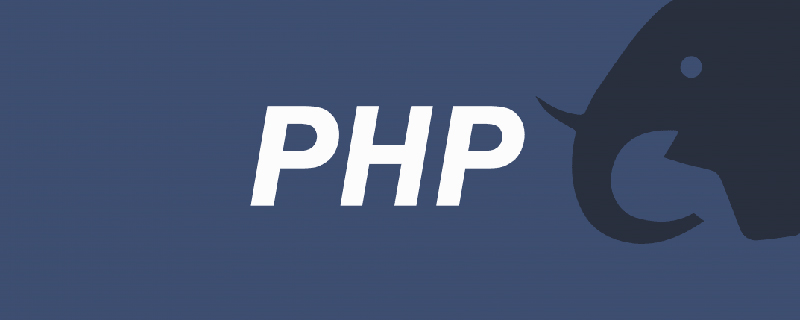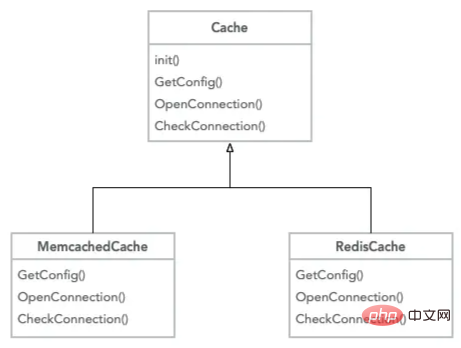An in-depth analysis of the template method pattern in PHP
In the previous article "Understand the facade pattern in PHP in one article" we introduced the facade pattern in PHP. This article will take you to understand the template method pattern in PHP design pattern.

The template method pattern is also one of the patterns that we often use inadvertently. This model is the best interpretation of inheritance. When there are repeated actions in the subclass, they are extracted and placed in the parent class for unified processing. This is the simplest and most popular explanation of the template method pattern. Just like when we usually do projects, the process of each project is actually the same, including research, development, testing, deployment and online processes. In each project, the implementation of these processes will not be exactly the same. This process is like a template method, allowing us to develop according to this process every time.
Gof class diagram and explanation
GoF definition: Define the skeleton of an algorithm in an operation, while deferring some steps to subclasses . TemplateMethod allows subclasses to redefine specific steps of an algorithm without changing the structure of the algorithm.
GoF class diagram

##Code implementation
abstract class AbstractClass
{
public function TemplateMethod()
{
$this->PrimitiveOperation1();
$this->PrimitiveOperation2();
}
abstract public function PrimitiveOperation1();
abstract public function PrimitiveOperation2();
}class ConcreteClassA extends AbstractClass
{
public function PrimitiveOperation1()
{
echo '具体类A实现方法1', PHP_EOL;
}
public function PrimitiveOperation2()
{
echo '具体类A实现方法2', PHP_EOL;
}
}
class ConcreteClassB extends AbstractClass
{
public function PrimitiveOperation1()
{
echo '具体类B实现方法1', PHP_EOL;
}
public function PrimitiveOperation2()
{
echo '具体类B实现方法2', PHP_EOL;
}
}$c = new ConcreteClassA(); $c->TemplateMethod(); $c = new ConcreteClassB(); $c->TemplateMethod();
- I believe that anyone who has done some object-oriented development will have used the template method pattern to some extent. Because it is very commonIn some frameworks, some functional classes often have the function of initialization, and many other internal functions are called in the initialization function. This is actually an application of the template method patternThe template method pattern can easily implement hook functions. Just like many templates or hook functions prepared for you in open source systems. For example, some blog open source programs will reserve some advertising spaces or hook functions in special locations for users to implement on demand. The template method pattern is suitable for: implementing the unchanged part of an algorithm at one time, and The variable parts are left to the subclass to implement; the common behaviors in the subclass are extracted and concentrated into the parent class; the extension of the subclass is controlled; This model embodies a thing called the "Hollywood Law" The principle is "Don't come to us, we come to you"
In the company, I highly recommend agile project management. Of course, this does not mean traditional project management. No matter how bad it is, it's just that agile is more suitable for a short-term, flat and fast company like ours. In agile, we use the Scurm framework, which is actually a template. It defines four types of meetings, three types of people, and three tools. In the specific implementation of each project, we will abide by these rules, but the specific implementation will not be the same. For example, sometimes we iterate once a week, and sometimes we iterate once a month. Sometimes we don't need a retrospective meeting, but hold the retrospective and review meetings together. No matter what, we will carry out flexible project development based on Scurm. As a leader, I only need to call up the basic process of Scurm in each project. Therefore, the strength of the company is inseparable from everyone’s learning. Of course, useful things must be learned, shared and applied all the time! !
Full code: https://github.com/zhangyue0503/designpatterns-php/blob/master/20.template-method/source/template-method.php
Example
No more text messages. This time we implement the initialization part of a Cache class. Just like the tool classes in some frameworks mentioned above. Generally, we will use Memcached or Redis to implement Cache, so we extract a public Cache class, and then let the Cache implementation classes of Memcached and Redis inherit it. In the public class, some initialization work of the implementation class is performed through template methods. These tasks are uniformly called by the parent class. The implementation class only needs to implement the specific content of each step.Cache class diagram

Full source code: https://github.com/zhangyue0503/designpatterns-php/ blob/master/20.template-method/source/template-method-cache.php<?php abstract class Cache { private $config; private $conn; public function __construct() { $this->init(); } public function init() { $this->GetConfig(); $this->OpenConnection(); $this->CheckConnection(); } abstract public function GetConfig(); abstract public function OpenConnection(); abstract public function CheckConnection(); } class MemcachedCache extends Cache { public function GetConfig() { echo '获取Memcached配置文件!', PHP_EOL; $this->config = 'memcached'; } public function OpenConnection() { echo '链接memcached!', PHP_EOL; $this->conn = 1; } public function CheckConnection() { if ($this->conn) { echo 'Memcached连接成功!', PHP_EOL; } else { echo 'Memcached连接失败,请检查配置项!', PHP_EOL; } } } class RedisCache extends Cache { public function GetConfig() { echo '获取Redis配置文件!', PHP_EOL; $this->config = 'redis'; } public function OpenConnection() { echo '链接redis!', PHP_EOL; $this->conn = 0; } public function CheckConnection() { if ($this->conn) { echo 'Redis连接成功!', PHP_EOL; } else { echo 'Redis连接失败,请检查配置项!', PHP_EOL; } } } $m = new MemcachedCache(); $r = new RedisCache();Copy after loginDescription
- We have implemented such a simple cache class. Is it very similar to the code in many frameworks?
- Subclasses only need to define their own implementation, and the rest of the repeated code is left to the parent class. If there is no parent class, they all need to implement an init() method themselves
- Of course, when you need to add other implementation classes, you only need to inherit this Cache parent class and complete your own implementation. Clients can face these implementation classes very easily because they know that they only need to call initialization first. Methods can use this class, no matter which implementation class it is, it is the same
Original address: https://juejin.cn/post/6844903989348139021
Author :Hard-core project manager
Recommended learning: "PHP Video Tutorial"
The above is the detailed content of An in-depth analysis of the template method pattern in PHP. For more information, please follow other related articles on the PHP Chinese website!

Hot AI Tools

Undresser.AI Undress
AI-powered app for creating realistic nude photos

AI Clothes Remover
Online AI tool for removing clothes from photos.

Undress AI Tool
Undress images for free

Clothoff.io
AI clothes remover

Video Face Swap
Swap faces in any video effortlessly with our completely free AI face swap tool!

Hot Article

Hot Tools

Notepad++7.3.1
Easy-to-use and free code editor

SublimeText3 Chinese version
Chinese version, very easy to use

Zend Studio 13.0.1
Powerful PHP integrated development environment

Dreamweaver CS6
Visual web development tools

SublimeText3 Mac version
God-level code editing software (SublimeText3)

Hot Topics
 1669
1669
 14
14
 1428
1428
 52
52
 1329
1329
 25
25
 1273
1273
 29
29
 1256
1256
 24
24
 PHP: A Key Language for Web Development
Apr 13, 2025 am 12:08 AM
PHP: A Key Language for Web Development
Apr 13, 2025 am 12:08 AM
PHP is a scripting language widely used on the server side, especially suitable for web development. 1.PHP can embed HTML, process HTTP requests and responses, and supports a variety of databases. 2.PHP is used to generate dynamic web content, process form data, access databases, etc., with strong community support and open source resources. 3. PHP is an interpreted language, and the execution process includes lexical analysis, grammatical analysis, compilation and execution. 4.PHP can be combined with MySQL for advanced applications such as user registration systems. 5. When debugging PHP, you can use functions such as error_reporting() and var_dump(). 6. Optimize PHP code to use caching mechanisms, optimize database queries and use built-in functions. 7
 PHP and Python: Comparing Two Popular Programming Languages
Apr 14, 2025 am 12:13 AM
PHP and Python: Comparing Two Popular Programming Languages
Apr 14, 2025 am 12:13 AM
PHP and Python each have their own advantages, and choose according to project requirements. 1.PHP is suitable for web development, especially for rapid development and maintenance of websites. 2. Python is suitable for data science, machine learning and artificial intelligence, with concise syntax and suitable for beginners.
 PHP in Action: Real-World Examples and Applications
Apr 14, 2025 am 12:19 AM
PHP in Action: Real-World Examples and Applications
Apr 14, 2025 am 12:19 AM
PHP is widely used in e-commerce, content management systems and API development. 1) E-commerce: used for shopping cart function and payment processing. 2) Content management system: used for dynamic content generation and user management. 3) API development: used for RESTful API development and API security. Through performance optimization and best practices, the efficiency and maintainability of PHP applications are improved.
 The Enduring Relevance of PHP: Is It Still Alive?
Apr 14, 2025 am 12:12 AM
The Enduring Relevance of PHP: Is It Still Alive?
Apr 14, 2025 am 12:12 AM
PHP is still dynamic and still occupies an important position in the field of modern programming. 1) PHP's simplicity and powerful community support make it widely used in web development; 2) Its flexibility and stability make it outstanding in handling web forms, database operations and file processing; 3) PHP is constantly evolving and optimizing, suitable for beginners and experienced developers.
 PHP and Python: Different Paradigms Explained
Apr 18, 2025 am 12:26 AM
PHP and Python: Different Paradigms Explained
Apr 18, 2025 am 12:26 AM
PHP is mainly procedural programming, but also supports object-oriented programming (OOP); Python supports a variety of paradigms, including OOP, functional and procedural programming. PHP is suitable for web development, and Python is suitable for a variety of applications such as data analysis and machine learning.
 PHP vs. Other Languages: A Comparison
Apr 13, 2025 am 12:19 AM
PHP vs. Other Languages: A Comparison
Apr 13, 2025 am 12:19 AM
PHP is suitable for web development, especially in rapid development and processing dynamic content, but is not good at data science and enterprise-level applications. Compared with Python, PHP has more advantages in web development, but is not as good as Python in the field of data science; compared with Java, PHP performs worse in enterprise-level applications, but is more flexible in web development; compared with JavaScript, PHP is more concise in back-end development, but is not as good as JavaScript in front-end development.
 PHP and Python: Code Examples and Comparison
Apr 15, 2025 am 12:07 AM
PHP and Python: Code Examples and Comparison
Apr 15, 2025 am 12:07 AM
PHP and Python have their own advantages and disadvantages, and the choice depends on project needs and personal preferences. 1.PHP is suitable for rapid development and maintenance of large-scale web applications. 2. Python dominates the field of data science and machine learning.
 PHP: Handling Databases and Server-Side Logic
Apr 15, 2025 am 12:15 AM
PHP: Handling Databases and Server-Side Logic
Apr 15, 2025 am 12:15 AM
PHP uses MySQLi and PDO extensions to interact in database operations and server-side logic processing, and processes server-side logic through functions such as session management. 1) Use MySQLi or PDO to connect to the database and execute SQL queries. 2) Handle HTTP requests and user status through session management and other functions. 3) Use transactions to ensure the atomicity of database operations. 4) Prevent SQL injection, use exception handling and closing connections for debugging. 5) Optimize performance through indexing and cache, write highly readable code and perform error handling.




